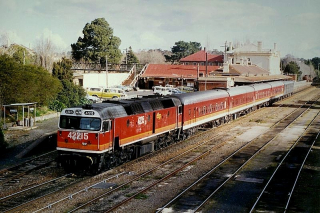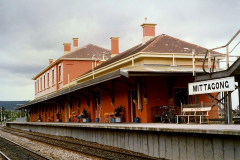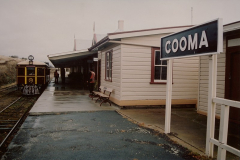Since railways began in 1854 in New South Wales, many and varied buildings have been in use as the network expanded. The early main lines were built in true English style, with single and double story sandstone stations, crossing keeper’s houses, and signal boxes all showing this classic image. Then as budget constraints were felt, NSW, like the rest of Australia, developed their own unique brand of standardized brick, and wooden structures, to grace their lines as the networks spread further out into the state. Eventually, the final designs for the far flung rural branches, were concrete slab shelters at the halts and sidings, while a town was given a larger version with waiting rooms, and offices, as required. Signal boxes ranged from large and ornate on brick and stone bases, to concrete slab and fibro, in a strict functional fashion. Again, as passenger rail services diminished from the 1970s onwards, the need for stations and crossing loops vanished with them.
The country part of the system suffered the most, and many places out bush have had all trace of their railway presence erased, except for maybe a through line, or a siding if the branch still operates. Outside of the suburban and interurban areas of Sydney, and the Newcastle – Maitland region, only the odd example remains standing, and those stations that do are generally in major regional centres, or wayside stops that are still served by Countrylink on the main lines.
Thankfully though, again in the country, nearly all the large and impressive buildings that are not in use have been preserved. Places like Hay, Narrandera, Tenterfield, Cootamundra West and others of the same standard are in no danger of demolition. What has been lost are most of the stations of timber construction, signal boxes, goods sheds and yards. In the suburbs of Sydney a great deal survives, but in many cases in altered and modernized forms. Only a few of the very early buildings stand, places like Liverpool, Parramatta and Emu Plains come to mind. The best working, and the “old” image of the NSWGR is at Mount Victoria, where there is also an ancient signal box is still in operation. Otherwise, for that same nostalgia that many people grew up with, Cooma, on the preserved Cooma Monaro Railway,has faithfully kept what is a mid sized country town station in its original form, complete with an operational signal box, signals and outbuildings.However, wander the branch lines of the NSWGR and there really is not too much left to see of what was there in the majority of cases. Nothing but flat ground, where once there was a building, and a service, of vital importance to a rural community.









